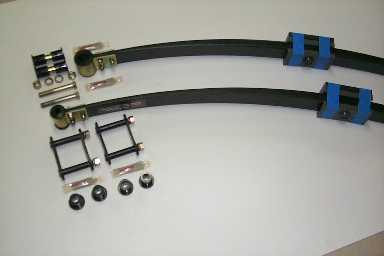BRITISH AUTOMOTIVE |
|
www.mgbmga.com MGTD Articles |
Technical Information (MGB 4)
Composite Leaf Springs
Last Modified - 01/28/03
An Introduction to Composite Springs - MGB4(1)

P0002538
There are numerous reasons why these types of springs are being used more
frequently as a replacement for steel leaf springs. One of the most advantageous
reasons for considering their use over steel is their weight. A steel leaf
spring, as fitted to the MGB, weighs approximately 20lbs, on the other
hand, the replacement composite leaf spring, using fiberglass reinforcement
in an epoxy matrix, weights approximately 5lbs. Other advantages are as
follows:
Reduced contribution to unsprung weight.....
Smoother ride when compared with a comparable steel spring rate, therefore allowing increased spring #'s where necessary.....
Material properties of the composite spring allow rapid response to induced or released stresses, which in turn allows better compliance with the road surface.....
Absorbs more of the road shock.....
No interleaf friction.....
No sagging or setting.....
Superior fatigue strength over steel.....
Reduced rear wheel bump steer.....
Excellent corrosion resistance.....
"Fail safe" capabilities.....
No lateral reset due to torque steer.....
Superior handling.....
These composite springs are tested to just beyond their "flat condition", spring #'s are recorded for every inch of this deflection and an average spring # established. According to the manufacturer, there is very little variation in spring #'s throughout the total deflection.
With the regular steel spring manufacturing process, there is a tolerance factor in the spring rate. This is also true during the composite spring molding process with a variable allowance of + or - 15 lb./in; this, however, should not present a problem. The most important point to remember is that both springs will be matched for spring rates and sold as a pair.
Composite springs, with their rapid response to induced and released stresses, will benefit from the fitment of gas telescopic tube type shock absorbers.
For additional information select from one of the following categories:
MGB4...Composite Leaf Spring Overview
MGB4(3)...MGB Vehicle Lean Problems
MGB4(4)...MGB Anticipated Ride Heights
MGB4(6)...General Installation Instructions